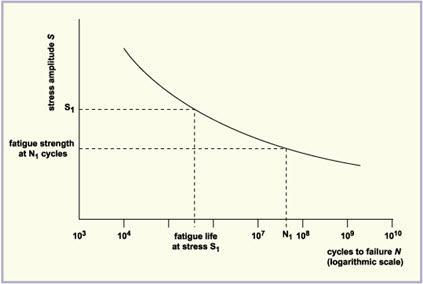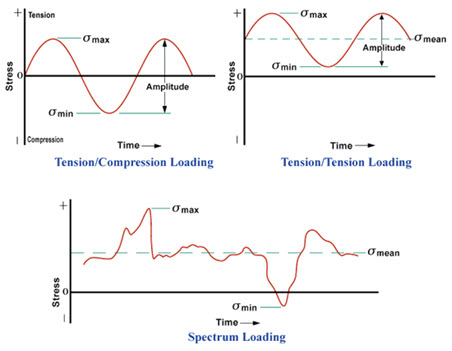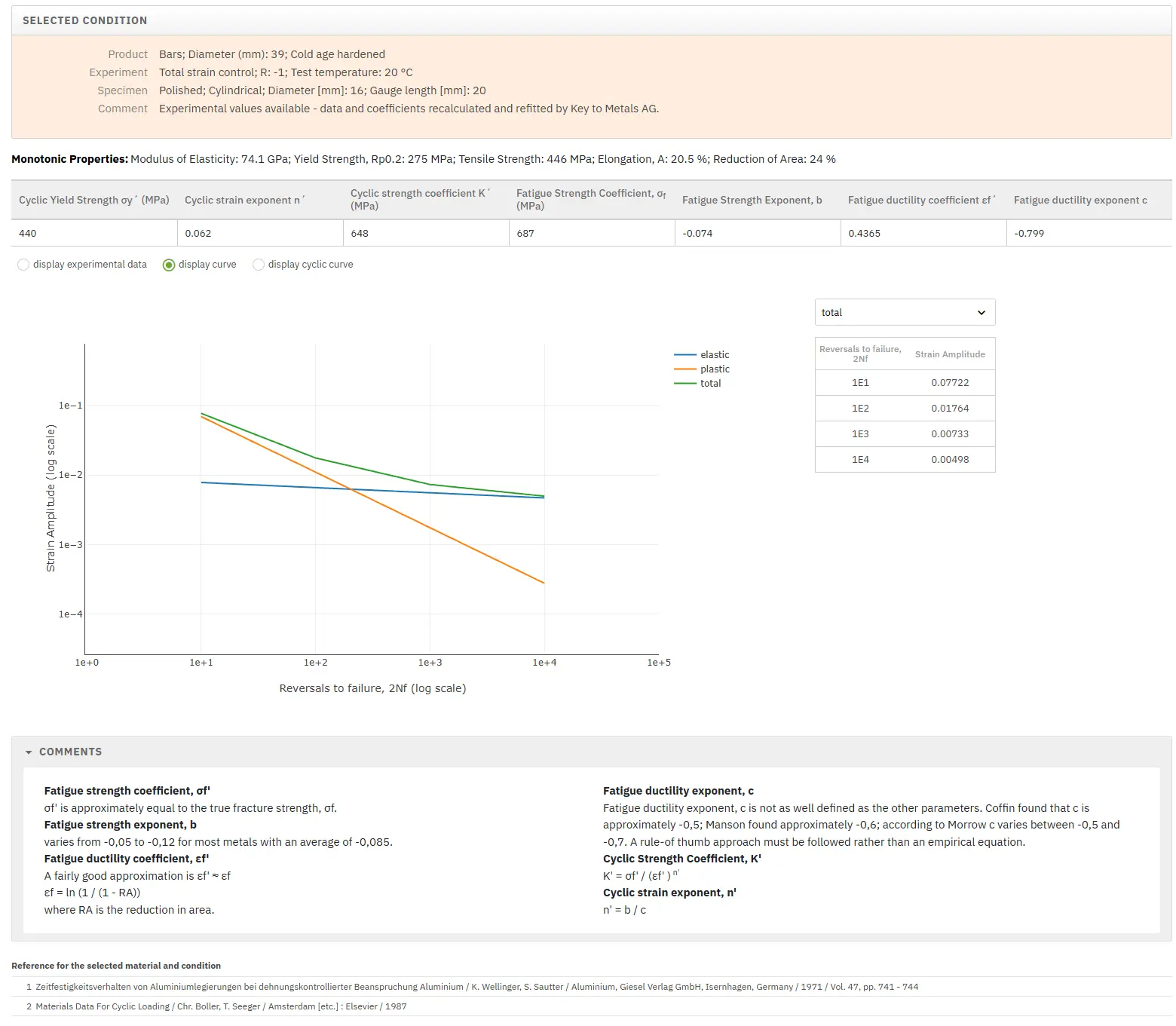Fatigue of Metals: Part Two
Abstract
Metal fatigue represents a critical failure mechanism in engineering structures subjected to cyclic loading conditions. This analysis examines the fundamental principles of fatigue behavior through S-N curve methodology, which plots stress amplitude against cycles to failure. The study distinguishes between high-cycle fatigue (>10³ cycles) analyzed through stress-life methods and low-cycle fatigue (<10³ cycles) evaluated using strain-life approaches. Key factors affecting fatigue life include loading patterns, stress levels, cycle frequency, surface conditions, and environmental variables. Understanding these fatigue mechanisms is essential for preventing catastrophic structural failures, as fatigue cracks initiate and propagate under stress levels below material yield strength, making early detection challenging and failure prediction critical for safe engineering design.
Understanding S-N Curves and Fatigue Data Presentation
The fundamental approach to presenting engineering fatigue data relies on the S-N curve, which plots stress amplitude (S) against the number of cycles to failure (N). This graphical representation serves as the cornerstone of fatigue analysis, providing engineers with essential data for predicting material behavior under cyclic loading conditions. The S-N diagram demonstrates how constant cyclic stress amplitude applied to specimens determines the loading cycles required until failure occurs.
Since millions of cycles may be necessary to cause failure at lower loading levels, the horizontal axis (abscissa) is typically plotted logarithmically to accommodate the vast range of cycle counts. This logarithmic scaling enables clear visualization of fatigue behavior across multiple orders of magnitude, from hundreds to millions of loading cycles.

Figure 1: Typical S-N Curves
The development of S-N curves preceded the microstructural understanding of fatigue processes, representing early empirical approaches to quantifying fatigue behavior and establishing design criteria. These engineering tools proved invaluable for developing safe design practices long before the underlying physical mechanisms were fully understood.
High-Cycle vs. Low-Cycle Fatigue Analysis
High-Cycle Fatigue Characteristics
High-cycle fatigue occurs under conditions involving low loads and extended service life, typically exceeding 10³ cycles. This fatigue regime is commonly analyzed using stress-life methodology, which encompasses both S-N curve analysis and total-life methods. The stress-life approach predicts the number of cycles a material can sustain before failure occurs, while the endurance limit concept establishes a threshold stress level that theoretically allows infinite service life (exceeding 10⁶ cycles).
Materials exhibiting clear endurance limits can operate indefinitely below this critical stress threshold, making this concept particularly valuable for designing components intended for extended service periods. However, not all materials demonstrate well-defined endurance limits, particularly non-ferrous metals and high-strength steels, which continue to accumulate damage even at very low stress levels.
Low-Cycle Fatigue Evaluation
Low-cycle fatigue is associated with higher loading conditions that induce plastic deformation and result in shorter service life, typically less than 10³ cycles. This fatigue regime requires strain-life analysis methods rather than stress-life approaches, as plastic deformation becomes the dominant factor controlling fatigue behavior.
Strain-life analysis accounts for both elastic and plastic strain components during cyclic loading, providing more accurate life predictions when significant plastic deformation occurs. This approach is particularly relevant for components experiencing high stress concentrations or operating under severe loading conditions where elastic limits are exceeded.
The Nature of Fatigue Cracking
Fatigue cracking represents one of the most significant damage mechanisms affecting structural components across numerous engineering applications. The insidious nature of fatigue damage stems from crack initiation and propagation under cyclic stresses that remain below the material's ultimate tensile strength or even yield strength.
The terminology "fatigue" reflects the concept that materials become progressively weakened or "tired" through repeated loading cycles, ultimately failing at stress levels significantly below their nominal static strength. This phenomenon creates particularly dangerous conditions because original bulk design strengths are not exceeded, and the primary warning sign of impending failure is often a barely visible crack that can be extremely difficult to detect during routine inspections.
The progressive nature of fatigue damage means that small, initially harmless cracks can grow gradually over many loading cycles until they reach critical dimensions, leading to sudden catastrophic failure. This delayed failure mechanism has been responsible for numerous structural failures in aircraft, bridges, pressure vessels, and rotating machinery throughout engineering history.

Figure 2: Typical fatigue stress cycles
Essential Factors Affecting Fatigue Life
Primary Requirements for Fatigue Crack Initiation
Three fundamental factors must be present simultaneously for fatigue crack initiation to occur. The loading pattern must contain sufficient variation between minimum and maximum peak values, creating adequate stress fluctuation amplitude. These peak values may occur in tension or compression and can vary over time, but the loading cycle reversal must be sufficiently large to initiate fatigue cracking mechanisms.
The peak stress levels must reach sufficiently high magnitudes to overcome the material's resistance to crack initiation. Stress levels below critical thresholds will not induce fatigue damage regardless of the number of applied cycles. The material must experience an adequate number of loading cycles to accumulate sufficient damage for crack initiation and subsequent propagation.
The relationship between these three factors is interdependent, with the number of cycles required for crack initiation and growth being largely determined by the stress amplitude and loading pattern characteristics. Higher stress amplitudes reduce the number of cycles required for failure, while lower stress levels may require millions of cycles to produce detectable damage.
Secondary Factors Influencing Fatigue Performance
Beyond the three primary requirements, numerous additional variables significantly affect fatigue behavior and component service life. Stress concentration effects, corrosion environments, temperature conditions, overload events, metallurgical structure, and residual stress states all influence fatigue crack initiation and propagation rates.
Surface condition plays a particularly critical role in fatigue performance since fatigue cracks typically initiate at component surfaces where stress concentrations are highest. Surface roughness directly correlates with the level and number of stress concentrations present, making surface finish quality a crucial design consideration.
Higher stress concentrations increase crack nucleation probability, while smooth surfaces extend the time required for crack initiation. Notches, scratches, tool marks, and other geometric stress concentrators significantly reduce fatigue life by providing preferential sites for crack initiation.
Impact of Residual Stresses on Fatigue Life
Surface residual stresses exert profound effects on fatigue performance, with compressive residual stresses generally beneficial and tensile residual stresses detrimental to fatigue life. Compressive residual stresses from machining operations, cold working processes, or heat treatment procedures oppose applied tensile loads, effectively reducing the amplitude of cyclic loading experienced by the material.
This stress interaction can substantially extend fatigue life by reducing the effective stress range driving crack initiation and propagation. Conversely, tensile residual stresses add to applied loads, accelerating fatigue damage accumulation and reducing component service life. Understanding and controlling residual stress states through appropriate manufacturing processes represents a critical aspect of fatigue-resistant design.
Shot peening, roller burnishing, and other surface treatment methods can introduce beneficial compressive residual stresses, significantly improving fatigue performance. These treatments are commonly applied to critical components such as aircraft engine parts, automotive suspension components, and high-performance machinery elements where fatigue resistance is paramount.
Implications for Engineering Design and Safety
The understanding of metal fatigue mechanisms and the factors influencing fatigue life has profound implications for engineering design and structural safety. Designers must consider not only static strength requirements but also the dynamic loading history that components will experience throughout their service life.
Proper fatigue analysis requires accurate characterization of loading spectra, environmental conditions, and material properties under cyclic loading conditions. This comprehensive approach enables the development of robust designs that can safely operate under intended service conditions while providing adequate safety margins against fatigue failure.
Regular inspection protocols and damage tolerance approaches have evolved to address the inherent challenges of fatigue damage detection and management. These strategies acknowledge that fatigue cracks may initiate despite careful design and focus on detecting and managing crack growth before it reaches critical dimensions.
Conclusion
Metal fatigue remains a critical consideration in engineering design and structural integrity assessment. The S-N curve methodology provides essential tools for characterizing material behavior under cyclic loading, while understanding the distinction between high-cycle and low-cycle fatigue enables appropriate analysis methods selection.
The complex interplay of factors affecting fatigue life, from loading patterns and stress levels to surface conditions and residual stresses, requires comprehensive consideration during design and manufacturing processes. As engineering systems continue to operate under increasingly demanding conditions, thorough understanding of fatigue mechanisms becomes ever more critical for ensuring safe and reliable performance throughout intended service life.
Uzyskaj dostęp do cyklicznych właściwości tysięcy materiałów już teraz!
Total Materia Horizon zawiera unikalną kolekcję właściwości zmęczeniowych materiałów metalowych i niemetalowych, zarówno dla zmęczenia niskocyklicznego, jak i wysokocyklicznego.

Uzyskaj BEZPŁATNE konto testowe w Total Materia Horizon i dołącz do społeczności ponad 500 000 użytkowników z ponad 120 krajów.